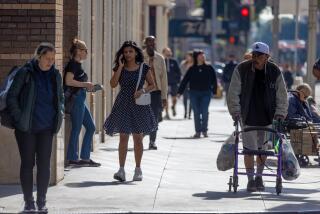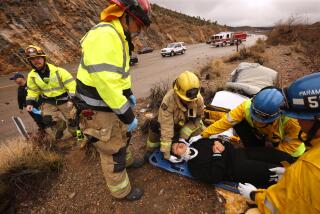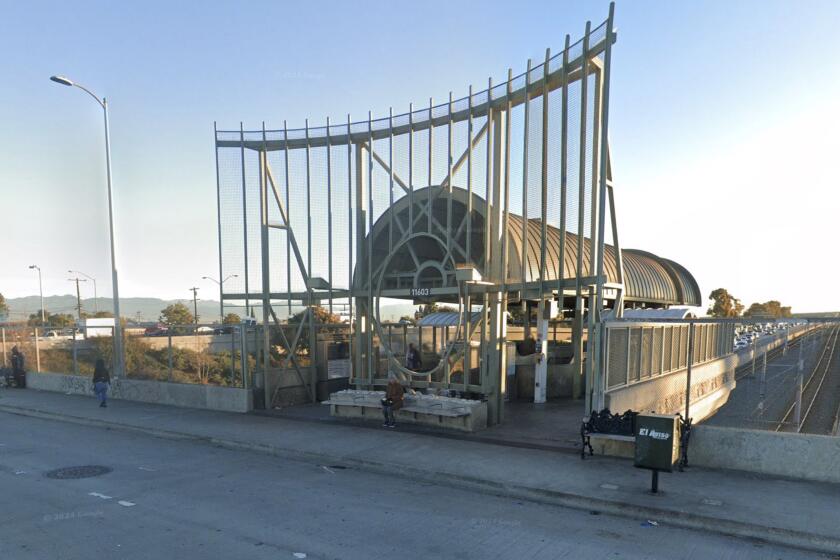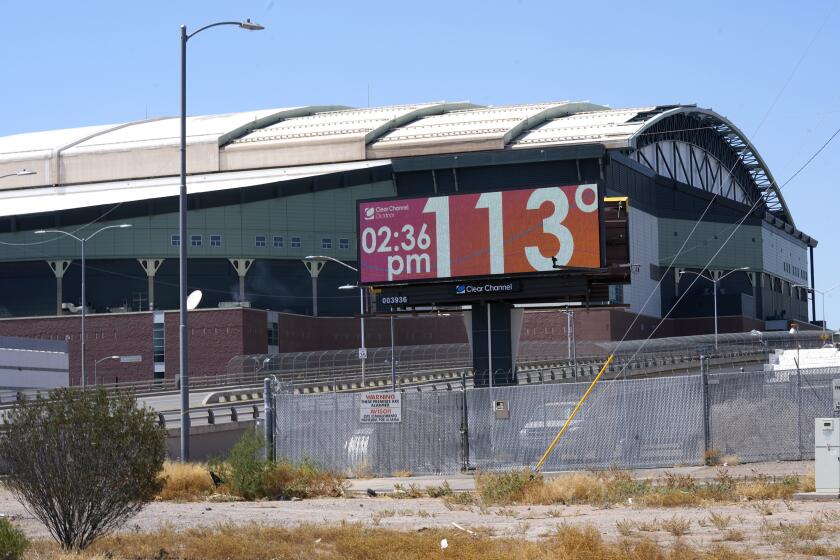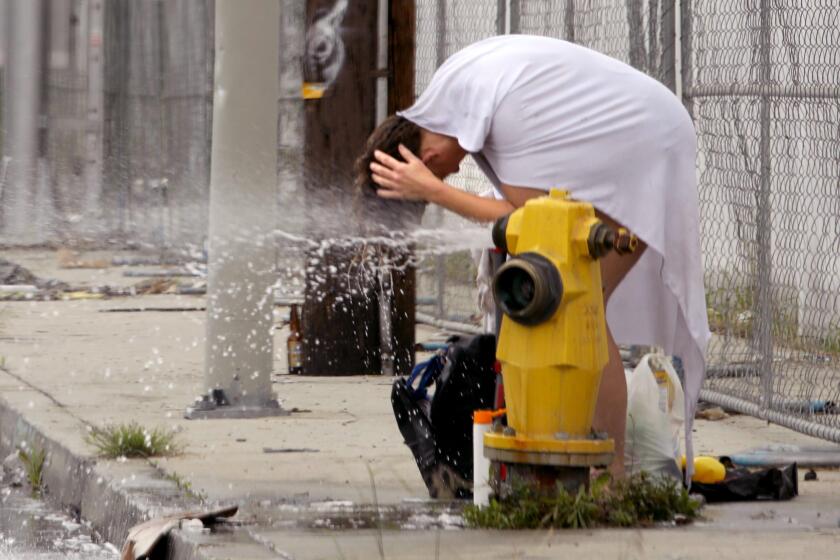When Crowds Exceed L.A.’s Posted Limits, Party’s Over
Until Rob Willcox showed up, it had been a typical Friday night at the Tropicana nightclub in Hollywood. The music was blaring; the $10 pitchers of beer were flowing. The customers were boisterous as they waited for the featured attraction--female mud wrestling--to start.
The crowd watched the combatants, but Willcox, a Los Angeles city fire inspector, ignored them. He was studying the club’s large upstairs room. A sign limited the occupancy to 294 people, but Willcox knew there were too many people there.
After calling for backup firefighters and police officers, Willcox halted the festivities.
“Your nightclub is closed for the evening,” he told the Tropicana’s managers, ordering them to instruct customers to file out as he tallied them on a hand-held counter to determine whether the city’s overcrowding law had been violated.
Angry Chants
Despite chants of “B.S., B.S., B.S.” and demands that their money be returned, the patrons complied. The final count was 346, well over the legal limit, which is based on number of exits, room size and seating arrangement.
Such one-night closures are occurring more and more frequently in Los Angeles these days, angering the operators of bars, restaurants and other places of “public assemblage,” defined as any establishment that can accommodate more than 49 people.
The no-nonsense approach to the Tropicana, one of three closures Willcox ordered on one recent night, is typical of Los Angeles’ strict enforcement of occupancy limits. If a violation is discovered, there is no discussion or warning. Closure for the rest of the business day is required.
The city’s position on the overcrowding ordinance is among the toughest of major U.S. cities.
Since 1981, when it closed 25 establishments, the Fire Department’s 16-member public assemblage unit has closed an increasing number of bars, restaurants and nightclubs each year, far more than in some cities of comparable size.
35 Closures Last Year
For example, 35 were closed in Los Angeles last year and fire officials estimate that at the current pace about 50 establishments may be closed this year.
By comparison, during 1987 and this year, although fire inspectors in New York and Chicago have made more than 10,000 inspections and issued about 600 summonses for corrective measures, neither city has ordered a single closure.
Los Angeles’ public assemblage unit goes out on nightly inspections every day of the year. New York inspectors also routinely work at night, but Chicago’s fire prevention unit does it only under special circumstances, officials said.
The Los Angeles County Fire Department, which inspects only occasionally at night because of its vast territory and budget constraints, has had no more than “five or six” shutdowns since the start of 1987, county Fire Capt. Lionel Salhus said.
While 50 closures may seem low for a city as big as Los Angeles, with about 3,000 public establishments that can hold at least 100 people, the Fire Department’s enforcement policies have drawn sharp criticism.
Owners of various establishments, ranging from gay bars and illegal underground clubs to Chippendale’s, the Westside spot that features male exotic dancing, have objected to conservative occupancy limits imposed by the city’s Building and Safety Department and fire authorities.
“It’s like a bridge that officials say can only support 50 cars,” said club operator Jack Marquette, who founded the once-popular but now-defunct Anti club. He has had several run-ins for overcrowding with authorities. “You know damn well they can hold a lot more than that.”
There also are other concerns. Earlier this year, gay community leaders met with authorities over the repeated closures of several Silver Lake-area bars.
While the gays generally recognized the concerns for overcrowding, they attacked the routine practice of calling police backup at a shutdown because it stirred up reoccurring fears of harassment.
Lately, criticism has been the loudest from Irish pub owners, who accuse fire inspectors of prejudice, harassment and arbitrary behavior. Their ire was prompted by the shutdown three weeks ago of two popular Fairfax district pubs, Tom Bergin’s and Molly Malone’s, on their busiest day of the year, St. Patrick’s Day.
‘Our Patron Saint’s Day’
“They didn’t even give us a chance,” said Angela O’Hanlon, the owner of Molly Malone’s who said her losses were too high to think about. “People were here to celebrate our patron saint’s day. There were no fights. By shutting us down, the Fire Department was saying that if you want to celebrate St. Patrick’s Day, you’ll have to go to New York or Chicago.”
Fire inspectors closed Molly Malone’s at 8:30 p.m. after counting 114 people inside, 25 over its occupancy limit. Another 100 people, outside in a line waiting to get in, were also told to leave. The shutdown order came on a second visit made by inspectors to the bar.
“It’s clear harassment,” O’Hanlon said. “Would they do the same thing to a Mexican restaurant on Cinco de Mayo?”
To her question, the inspectors’ boss, Battalion Chief Raymond Olsen, replied:
“If we get a complaint, we’ll check it out. But we won’t single them out.”
However, in the case of the two Irish pubs, fire officials said inspectors had received not complaints about overcrowding but were routinely in the area when they decided to check the bars.
Responding to criticism of the city’s tough enforcement of occupancy limits, fire officials point out that there has been no major loss of life from a fire in a restaurant or bar in Los Angeles since 1957 when six people died in the firebombing of the crowded Mecca Club bar in Boyle Heights.
“All we’re trying to do is keep these people alive,” argued Inspector F. E. (Gene) Fairrington, who does follow-up work on the shutdowns. “Does that make us the bad guys? If something happens, we’re the ones who have to go in and carry the bodies out.”
In interviews, fire officials repeatedly said they wanted to avoid a fire similar to the 1977 blaze that claimed 165 lives in the Beverly Hills Supper Club in Newport, Ky. Scores of the victims in that inferno died while trying to escape. Many of the bodies were found stacked up in doorways.
Reflecting on his closure of the Tropicana--its first ever--Fire Inspector Willcox observed: “If something had happened, could all of those 346 people have gotten out? I don’t think so.”
1982 Decision
The policy of stringent enforcement stemmed from a Fire Department decision in 1982 to uniformly enforce laws governing overcrowding, lighted and proper exits, authorized equipment on fire-retardant doors and floor plans.
Up to then, Olsen said, enforcement had been inconsistent and led to complaints of favoritism by some restaurant operators.
“We wanted to take some of the guesswork out of the field inspector’s hands,” Olsen said. “I mean before, some inspectors might see an overcrowded condition but think, ‘Well, the owner’s a nice guy, so I won’t cite him.’ Or maybe close some other guys but not the nice guys.”
While giving latitude to inspectors proved nettlesome in Los Angeles, fire officials in New York and Chicago said that approach works in their cities.
“We try to convince people to obey Law 41,” New York fire spokesman John Mulligan said, referring to the city’s overcrowding ordinance. “If we find someone who is close or over, we’ll ask him to throw out ‘x’ number of people to comply. We don’t want to provoke a riot.”
No disturbances have been reported here in connection with shutdowns, mainly because of the presence of police officers, Olsen said.
The 16 inspectors in the city’s public assemblage unit, which operates on a $2-million budget, make annual checks of establishments within assigned geographic areas. Those places may range from buildings higher than six stories to a Burger King that seats more than 100 people. (Local fire stations handle occupancy limits of under 100.)
At night, the inspectors may look in some of these places before they get busy on complaints. Most inspections are done at random to avoid the appearance of harassment, Olsen maintained.
And some, like in the case of the Tropicana, are made on the spur of the moment.
Scouts Posted
Los Angeles’ tough policy has prompted some restaurants and bars to try to avoid detection. Scouts are routinely perched on roofs to look out for inspectors.
“Sometimes, they know I’m here before I get out of my car,” Willcox said.
Some operators have resorted to ingenious and amusing attempts to foil the inspectors.
Veteran fire officials still shake their heads at what occurred at the Red Onion restaurant and bar in Woodland Hills one night a few years ago.
Fire Department records show that a supervisor near the bar, learning that an inspection of the crowded dance floor was imminent, told the crowd around him:
“Five-cent margaritas in the bar!”
More than a few patrons gladly quit dancing for a cheap drink. But among those who heard the offer was an undercover policeman who was there on an unrelated matter. He subsequently gave a declaration to fire authorities, who closed the Canoga Avenue establishment that night.
Red Onion officials declined comment. When asked about the incident, Ralph Saltsman, the restaurant chain’s attorney, replied, “That’s ancient history.”
Despite the tough policy, authorities said the Fire Department has had to deal with some public places that frequently violate their occupancy limits:
- Red Onion restaurants in the Wilshire District and Woodland Hills. They have been closed a combined total of 15 times since early 1984, fire records show. While Saltsman disputed the number of shutdowns and contended that there have been no problems in some time, officials in the public assemblage unit said several cases against them are pending before the Fire Commission.
- Chippendale’s in Palms. Fire officials say the popular nightclub, which has been closed 14 times since February, 1983, is a constant source of problems. Fire officials are said to be preparing a case that could led to the nightclub’s closure for an extended period.
(In city history, only one establishment--the Fantasia disco in the Bonaventure Hotel--has been closed more than one day, for repeated overcrowding. Its operating permit was suspended for 30 days.)
- Al’s Bar, a popular club for live music in the artist loft-warehouse area southeast of Civic Center. Its occupancy limit is only 49 people because of its one exit and its floor plan. According to records, it has been closed nine times for overcrowding since January of last year. On one of those occasions, 345 were inside. Its owner, Mark Krisel, has made more than $30,000 in improvements that would increase the occupancy limit to 176. But he charges that fire officials and a myriad of city departments have been slow to agree to the increase.
Most problems arise because proprietors do not count their employees toward the occupancy limit. Too often, operators will give an inquiring inspector only the count of the patrons inside, fire officials said.
‘Didn’t Include Staff’
“If the limit is, say, 300 and the manager says he’s got 300 inside, he’s probably over because he didn’t include the staff,” Willcox said.
Of particular concern nowadays to authorities are the underground clubs that operate without any police or fire permits in old warehouses, abandoned buildings or in posh business offices.
Willcox and the other inspectors are on constant watch for them, occasionally checking out posters tacked to walls and light poles for illegal gatherings.
In the waning minutes of the recent Friday night inspections, Willcox and a supervisor, Capt. Luis R. Acuna, found such a place when they wheeled into an alley behind the 3400 block of West Melrose Avenue in East Hollywood.
At 1:54 in the morning, the alley was crowded with black-leathered punkers. Loud music came out of a narrow doorway. An illegal club, calling itself the Krypt for the night, had been discovered. “It’s been called other things before,” Willcox said.
The concern for such places seemed well-founded inside. Black flammable plastic bags were draped throughout the multiroom “club” and lighted candles in some obscure corners were the only illumination. Because of the one exit, the legal limit would be 49. Willcox counted 194 people inside.
“It’s really unbelievable,” Acuna muttered. “These people are just looking for trouble. All you need is one flame by the door and that’s it.”
More to Read
Start your day right
Sign up for Essential California for news, features and recommendations from the L.A. Times and beyond in your inbox six days a week.
You may occasionally receive promotional content from the Los Angeles Times.
